|


The Serious Freshening
Go to <Last, Summary, Next>
Exterior—Rear Hatch And Deck Redeux
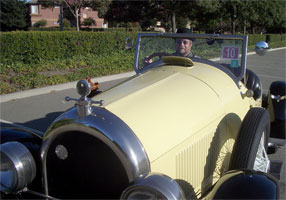
Lynn in Bugsby, September 5, 2005
|
Completed: 2007-04-14 — Started: 2006-03-10
|
TAIL ENDS:
Rear views of Bugsby (left), Al Nippert's 1923 car (left center), Phil Renuart's 1924 car (right center),
and DeWayne Ashmead's 1925 car (right).
|
Work Completed:
Initially Lynn thought the difference of the rear metal on Bugsby compared with other speedsters as a
variation due to the hand built nature of Kissel cars.
However in communications with John Lewis,
Lynn learns that the rear metal had been chopped off Bugsby in the 1940's when it was converted
to a farm utility vehicle (pickup truck).
Apparently when the car was initially restored in the early 1960's, the original rear metal was lost so
Ron Griffiths sectioned the rear deck from
a late 1930's or early 1940's Chevrolet roadster to achieve a rough analog to what some have called
the turtle-back or bumble-bee
shape characteristic of Kissel speedsters.
As he considers restoring the roof, Lynn realizes that the hatch is too far forward.
When open and folded down, its clear that a roof will cover the hatch, preventing it from being
opened.
Lynn begins to ask other Kissel owners about what the original rear hatch looked like.
He's surprised to learn that 1923-24 Model 6-55 Speedsters had a single large hatch that was
hinged in the front and opened to the rear. Further, this hatch was raised off the surface of the
rear deck. That is, it was not flush mount with the surface of the rear deck.
Apparently this particular hatch configuration is unique to the 1923-1924 Model 6-55 Speedsters as earlier
Model 6-45's and later Model 6-55's had two flush mounted hatches.
Joe Leaf sends Lynn a
copy of Kissel Body Department Drawing #1122-B.
This is a critical piece of information and helps Lynn understand more clearly
what the rear of Bugsby should look like.
John Lewis lends Lynn a full scale hand drawing of the hatch. This is extremely helpful as the
drawing notes a number of important construction details including the form of the wooden framing that
is part of the hatch.
However, a number of details (such as the shape of the hinges, lips and framing of the hole) are still a mystery.
Lynn contacts other 1923 and 1924 Model 6-55 Speedster owners and asks them to send him pictures of the
rear metal and hatch of their cars. Lynn is very pleased with the warm reception he gets from his cold
calls to
Al Nippert (1923),
Don Bosco (1923) and
Phil Renuart (1924).
All three of these individuals graciously agree to send Lynn information.
Based on the drawing from Joe Leaf, the full size drawing from John Lewis
and the photos of other 1923 and 1924 Model 6-55 Speedsters, Lynn approaches
Kevin Schell and asks him to consider modifications
to the hatch and rear metal to remake them closer to the original factory configuration.
It takes some time before Kevin agrees to undertake this additional scope of work.
Kevin spends many hours studying the material that Lynn has developed.
Lynn and Kevin eventually agree on the cost of the new work, but Lynn is certain that Kevin has given him a
big break.
Lynn continues to be very pleased in his interactions with Kevin and the interest he's taken in
the restoration of Bugsby.
|
REAL WORK BEGINS &mdash April, 2006:
Kevin uses a black marking pen to draw guidelines for new hatch opening and shape
of trailing edge on exposed metal of Bugsby (left).
On April 27, Kevin makes the first cuts for the new hatch opening (center).
Since he has easy access, Kevin decides to support the new hinges with a metal strut rather
than off the wooden framing (right).
|
|
WORK CONTINUES — May, 2006:
On May 10, Kevin cuts an 18" radius in the metal to establish the rear edge of the deck (left).
On May 19, he creates the lip of a new hatch opening (center).
On May 23, Lynn's father-in-law, Walter, and Kevin inspect
progress on new hatch (right).
|
Lynn is working on a joke concerning his interaction with Kevin on the new hatch.
When they were first discussing the work, Lynn was exploring with Kevin how much of the old hatch
could be reused.
Kevin quipped that he would not be able to use any of the old hatch, and that he would
only be able to use about 1/2 of the old hole!
Lynn countered that he thought Kevin would need all of the old hole, all he needed to do was just
move it around a little.
|
MORE METAL COMES OFF — June 9, 2006:
Kevin Schell poses with the body of Bugsby (left), the last day his shop is open before
Lynn leaves for the 100 year anniversary celebration.
Although more metal has disappeared, we're really making progress.
Kevin has established the rim of the new hatch and has removed all the old metal with the incorrect
shape.
He has also fabricated the rear oak bulkhead and the forward compartment bulkhead and hatch.
Beto (center), one of Kevin's most trusted body men, is doing the balance of the body work on Bugsby.
Lynn notes with some satisfaction that Kevin has mounted the Kissel Kar Service Station sign that Lynn
gave him.
|
|
NEW METAL IS BACK ON — Aug. 11, 2006:
Kevin has finished enclosing the rear deck.
He asks Lynn to bring Bugsby's chassis into his shop so that he can make adjustments to body panels
before final body work starts.
The men from Kevin's three business, plus the owner of a neighboring body shop, help to
lift Bugsby's body and place it gently on the chassis.
|
|
FIRST PRIMER — Sep. 14, 2006:
The major work on the rear deck is complete and a first coat of primer/sealer is applied.
The Kissel Speedster "turtle back," or "bumble bee" shape is clearly evident.
|
|
REFINED KISSEL SHAPE — Oct. 3, 2006:
The smooth curves of the rear deck fully emerge with skillful application of body filler.
The curves are vaguely sensual and quite different from its earlier shape.
|
HATCH IS VIRTUALLY COMPLETE — Feb. 9, 2007:
By mid December, 2006, Kevin had completed the hatch cover and applied another coat of primer to the deck.
Shaping the hatch cover required untold hours of manual effort by Kevin with a mallet and shot bag.
Progress was stalled for about two months until a suitable latch was fabricated.
Kevin installed the new latch within days of receiving it.
The long months are beginning to show as Kevin needs to add air to the cart tires and as
the thickness of the accumulated dust deepens.
|
|
HATCH IS COMPLETE — Apr. 14, 2007:
The surface contour of the hatch is complete after 13 months of effort. Yahoo!
|
Work Remaining:
None.

Contact  with your comments or questions with your comments or questions
Copyright © 2018 Lynn Kissel
Last updated: May 24, 2009
|


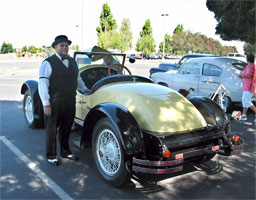
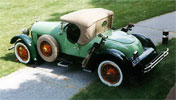

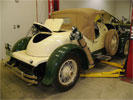
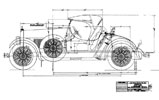


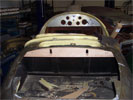


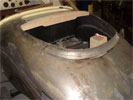



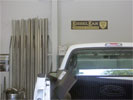
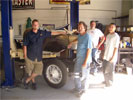
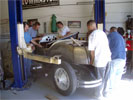
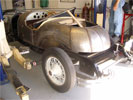

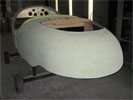

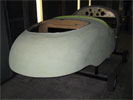


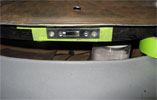



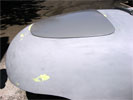
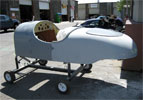
 with your comments or questions
with your comments or questions